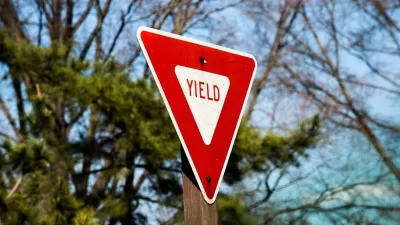We solve problems with over-engineered, anti-urban infrastructure schemes even though we have no plan for funding their future maintenance obligations. Howard Blackson uses San Diego as an example, and offers up some pedestrian-oriented solutions.
"Here in Southern California, we suffer from a local medical condition I’ve coined our Infrastructure Deficit Disorder (IDD).
"My city is falling apart. Sewers leak into stormwater outfalls during every rain event. Then our ocean is polluted for days afterwards. Our sidewalks and overly wide streets are crumbling, and our parks have been deficient since John Nolen identified the problem in his 1926 Comprehensive Plan for San Diego. Our Community Plans are 30 years old, doing little to provide predictability in the development process, meaning every new project of any scale is seen as a threat to a fantastic, yet precarious, quality-of-life. And, because we still measure traffic by the archaic Average Daily Trips generated by singular Land Uses, all new mitigation for mixed-use, walkable neighborhoods ends up being signalized intersections to facilitate the wider, faster streets required to avoid the feared LOS F (traffic traveling slower than 30 mph) performance rating.
"The net result: We’re keeping our neighborhoods from ever being mixed-use and walkable."
Howard Blackson goes on to offer up some solutions that include focus on revenue generation and changing measurement practices to maximize prior investments. He sums up with a Balboa Park example of a looming infrastructure investment choice, along with his own urban design solution.
FULL STORY: By-Passing Tomorrow for Easy Implementation Today

Alabama: Trump Terminates Settlements for Black Communities Harmed By Raw Sewage
Trump deemed the landmark civil rights agreement “illegal DEI and environmental justice policy.”

Planetizen Federal Action Tracker
A weekly monitor of how Trump’s orders and actions are impacting planners and planning in America.

The 120 Year Old Tiny Home Villages That Sheltered San Francisco’s Earthquake Refugees
More than a century ago, San Francisco mobilized to house thousands of residents displaced by the 1906 earthquake. Could their strategy offer a model for the present?

In Both Crashes and Crime, Public Transportation is Far Safer than Driving
Contrary to popular assumptions, public transportation has far lower crash and crime rates than automobile travel. For safer communities, improve and encourage transit travel.

Report: Zoning Reforms Should Complement Nashville’s Ambitious Transit Plan
Without reform, restrictive zoning codes will limit the impact of the city’s planned transit expansion and could exclude some of the residents who depend on transit the most.

Judge Orders Release of Frozen IRA, IIJA Funding
The decision is a victory for environmental groups who charged that freezing funds for critical infrastructure and disaster response programs caused “real and irreparable harm” to communities.
Urban Design for Planners 1: Software Tools
This six-course series explores essential urban design concepts using open source software and equips planners with the tools they need to participate fully in the urban design process.
Planning for Universal Design
Learn the tools for implementing Universal Design in planning regulations.
Clanton & Associates, Inc.
Jessamine County Fiscal Court
Institute for Housing and Urban Development Studies (IHS)
City of Grandview
Harvard GSD Executive Education
Toledo-Lucas County Plan Commissions
Salt Lake City
NYU Wagner Graduate School of Public Service




























